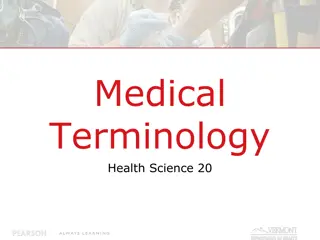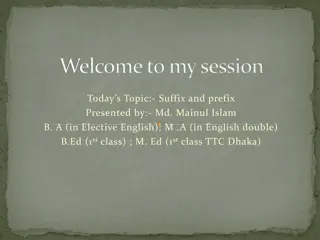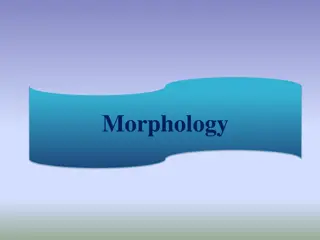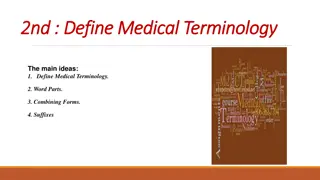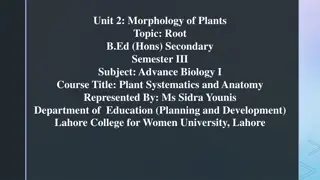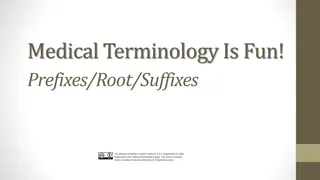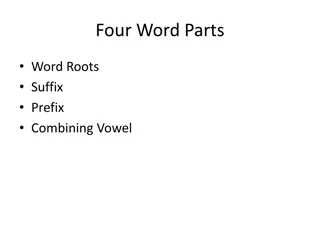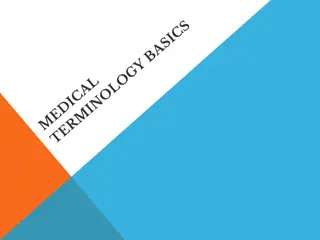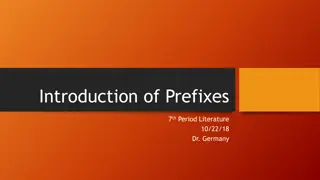Understanding Medical Word Elements: Roots, Combining Forms, Suffixes, and Prefixes
Medical terminology uses word elements like roots, combining forms, suffixes, and prefixes. Word roots provide the main meaning, combining forms connect elements, suffixes modify word meaning, and prefixes are placed at the beginning of words. Examples illustrate how these elements are used in medical terms.
Download Presentation

Please find below an Image/Link to download the presentation.
The content on the website is provided AS IS for your information and personal use only. It may not be sold, licensed, or shared on other websites without obtaining consent from the author. Download presentation by click this link. If you encounter any issues during the download, it is possible that the publisher has removed the file from their server.
E N D
Presentation Transcript
1 CHAPTER 1 BASIC ELEMENTS OF A MEDICAL WORD
LANGUAGE OF MEDICINE Specialized vocabulary used by health-care providers Medical words composed of word elements, also known as word parts, and consisting of some or all of the following elements: Word root (WR) Combining form (CF) Suffix Prefix
WORD ELEMENTS Word root (WR) Foundation of the word that contains its main meaning Usually derived from Latin or Greek language At least one word root in most medical words Some medical words, such as heart and blood, derived from early versions of French or English language without a word root
WORD ELEMENTS Examples of words with roots hepat in hepat/itis tonsill in tonsill/ectomy gastr in gastr/oma laryng in laryng/itis
WORD ELEMENTS Combining form (CF) Created when a word root is combined with a vowel, known as a combining vowel Combining vowel usually an o, but sometimes an i or an e Difficulty pronouncing certain combinations of word roots requires insertion of a vowel No meaning of its own, but a combining vowel enables two or more word elements to be connected
WORD ELEMENTS Combining form (CF) (continued) Examples of words with CFs mamm/o in mamm/o/gram psych/o in psych/o/logy laryng/o in laryng/o/spasm hepat/o in hepat/o/megaly
WORD ELEMENTS Suffix Word element placed at the end of a word Changes the meaning of a medical word Contained in most medical words Usually an indication of a pathology, condition, symptom, therapeutic or diagnostic procedure, or part of speech
WORD ELEMENTS Suffix (continued) Examples of words with suffixes -ectomy in append/ectomy -itis in appendic/itis -oma in neur/oma -tomy in crani/o/tomy -scope in gastr/o/scope -oma in gastr/oma
WORD ELEMENTS Prefix Word element placed at the beginning of a word Many the same as those used in the English language Changes the meaning of a medical word Not contained in all medical words Usually an indication of a number, time, position, measurement, direction, or negation
WORD ELEMENTS Prefix Examples of words with prefixes hyper- in hyper/tension hemi- in hemi/plegia epi- in epi/derm/al post- in post/nat/al inter- in inter/cost/al
DEFINING MEDICAL WORDS Three steps for defining medical words 1. Define the suffix first. 2. Define the first part of the word (WR, CF, or prefix). 3. Define the middle part of the word (WR or CF).
BUILDING MEDICAL WORDS Three rules for building medical words Rule 1: A WR links a suffix that begins with a vowel. Rule 2: A CF links a suffix that begins with a consonant. Rule 3: A CF links a root to another root to form a compound word. Rule 3 holds true even if the next root begins with a vowel, as in gastr/o/intestin/al.
PRONOUNCING MEDICAL WORDS Diacritical marks and capitalization help with pronunciation of terms throughout the text and understanding of pronunciation marks used in most dictionaries. Pronunciation guidelines are located on the inside front cover of the textbook and at the end of Anatomy and Physiology Key Terms tables.



